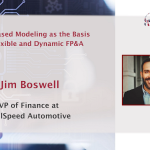Learn from Jim Boswell, VP of Finance at FullSpeed Automotive about the best practices in building Driver-Based...

In this series of blogs, I will be providing a comprehensive approach to the design, construction, roll-out and maintenance of a modern analytic planning solution.
Why Driver-Based Planning?
Driver-based planning is an essential tool for FP&A. The models produced not only improve the speed and efficiency of developing plans but also pave the way to making it a continuous activity and creating more accurate forecasts and meaningful scenarios. Yet despite this, it’s still a little used tool.
Driver-based plans are typically built using multi-dimensional analytic models that describe how the organisation operates. They use mathematical relationships to link variables such as material cost, market size and sales conversion rates to calculate items such as sales revenue, production and other related costs throughout the organisation. These are then consolidated by the model to produce financial statements and supporting analyses.
The ‘driver’ relationships are discerned through past results, trends and management intuition to predict the organisation’s future.
By varying the input numbers and adjusting the relationships, various scenarios can be generated for management to consider. The most likely scenario is then chosen as a forecast or budget.
In either case, actions are typically required to make the scenario a reality, minimise risk, and/or maximise performance. In essence, driver-based planning is not a replacement for management perception but a tool that can be used to guide decision-making.
Where Do You Start in Building Such a Model?
There is a great temptation to start building a model without first considering what’s involved. Spreadsheets beckon this approach, as with a few deft keystrokes, a user can set up a model that will generate a consolidated P&L based on a few assumptions about costs and sales forecasts. But there is more to a driver-based model than a set of formulae defined on a spreadsheet or within a sophisticated analytic model.
In the same way that you would never build a car without first considering what you want to transport and where you want to go, so it is with developing a driver-based model. And don’t consider buying software and expect it to solve all your problems.
Software is just an enabler – the best software in the world will not be successful if the analytic model is ill-conceived.
So with that in mind, here are the steps required to build a driver-based planning model that will benefit the organisation:
- Determine the purpose of the model(s),
- Define the reports and analyses required,
- Identify the users,
- Find the data,
- Choose the software,
- Build and test the model,
- Automate the model,
- Roll out the model,
- Review and modify it.
In this series of blogs, I will take each step in turn and give you pointers on how to conduct each stage within your organisation.
This article was first published in Unit4/Prevero blog.
Subscribe to
FP&A Trends Digest

We will regularly update you on the latest trends and developments in FP&A. Take the opportunity to have articles written by finance thought leaders delivered directly to your inbox; watch compelling webinars; connect with like-minded professionals; and become a part of our global community.




